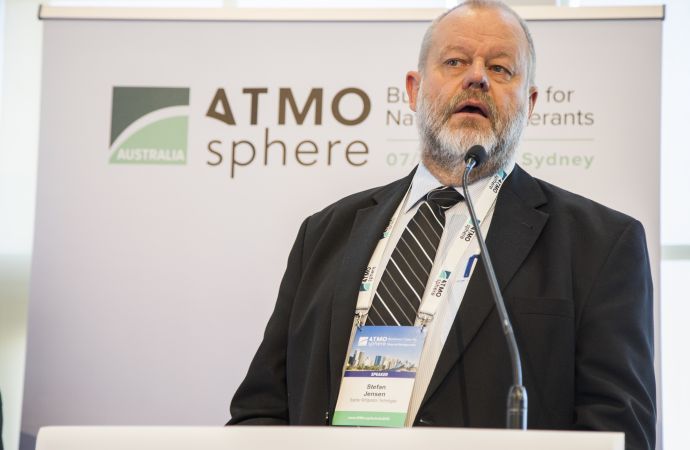Not all liquid overfeed plants will have a “penalty” this big, but investing in low-charge DX systems is still good business in most cases, according to Stefan Jensen.

Stefan Jensen, Scantec, at the ATMosphere Australia conference in 2018.
Dry expansion (DX) low-charge ammonia systems can be up to 30% more energy efficient than traditional liquid overfeed systems, according to Stefan Jensen, Managing Director of Australia-based Scantec Refrigeration Technologies, speaking at the IIR Conference in Ohrid, North Macedonia, on September 16.
As an example of the “cost” of liquid overfeed, Jensen described two “conceptually almost identical projects” in Malaysia and Brisbane, Australia, which have similar climates. The DX installation in Brisbane has a specific energy consumption (SEC) of 15kWh/m3/year, compared to 21 for the liquid overfeed installation in Malaysia, a difference of 28%.
The difference is “what it costs in energy terms to circulate relatively high density liquefied refrigerant in the suction line network," Jensen said.
Why is this the case? “There is no real modeling tool that we can use [to explain the difference between DX and liquid overfeed],” Jensen said, stressing that it depends on system design.
Describing a plant with ceiling-suspended evaporators, Jensen said “it has all these little risers that come out of the evaporators … these risers will invariably in liquid overfeed systems go into flow reversal at part load. This does not happen in the DX systems because we do not have any liquid in the suction lines.”
“This, I believe, is the key to explaining the big difference in energy performance between liquid overfeed and dry expansion in this case.”
However, “this case is not universal, I mean there are other plants where we can design the plant so that the liquid runs downhill all the way. Those plants are not very common, but they do exist, and in those cases the penalty is unlikely to be 30%, it's likely to be much less.”
The ammonia business case
During his presentation, Jensen talked about the business case for low-charge DX ammonia, asking whether it can be justified to replace older ammonia systems with new modern ones, and answering his own question with a resounding yes.
As an example, Jensen told his audience of an Australian cold storage operator with two very similar warehouses in Lismore and Tamworth. Tamworth has a DX ammonia system, and Lismore a flooded ammonia system with screw compressors.
Replacing the Lismore system with a system similar to Tamworth’s will result in savings of more than AUS$250,000 per year (US$182,000/€155,000), meaning a payback period of only 4.5 years, despite the AUS$1.2 million initial cost to replace the system (US$873,500/€744,000). "This is another case of the customer simply not being able to afford not doing this. It's cash flow positive from day one," Jensen said. The installation will be finished next month, he added.
Another example is a cold storage operator from the Melbourne area, who chose to combine three older HFC-based warehouses into one new DX ammonia cooled facility, saving AUS$500,000 (US$364,000/€310,000) per year in energy costs. “He basically will be able to return this investment in about six years, the simple payback is six years,” Jensen said. “The operating lease for the facility is 15 years, so when he is halfway through the operating lease the ammonia plant is fully paid for, in energy consumption and cost reduction.”
"So, is liquid overfeed as a concept nearing the end of its useful life? Well, I believe the answer to that question is in the affirmative," Jensen concluded.
So, is liquid overfeed as a concept nearing the end of its useful life? Well, I believe the answer to that question is in the affirmative," - Stefan Jensen, Scantec.
Want to find out more, or have something to say about this story? Join the ATMO Connect network to meet and engage with like-minded stakeholders in the clean cooling and natural refrigerant arena.
Related stories



